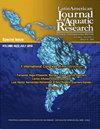Comparative study of serum biochemical and hematological parameters of Andinoacara rivulatus and Ichthyoelephas humeralis in Los Ríos Province, Ecuador
IF 0.8
4区 农林科学
Q3 FISHERIES
Latin American Journal of Aquatic Research
Pub Date : 2022-05-01
DOI:10.3856/vol50-issue2-fulltext-2795
引用次数: 2
Abstract
A comparative study of serum biochemical and hematological parameters from Andinoacara rivulatus and Ichthyoelephas humeralis in Los Ríos Province, Ecuador, was carried out. Two of the native species that are the most commercialized in Quevedo, Mocache and Fumisa, were identified; 60 specimens were captured in each area (180 total). A factorial design (3×2) was used: three habitat zones (Fumisa, Quevedo, and Mocache) and two species (A. rivulatus and I. humeralis). Sex, weight, length, serum biochemistry (total protein, albumin, globulin, albumin/globulin ratio, aspartate aminotransferase (AST), alanine aminotransferase (ALT), calcium, phosphorus, sodium, magnesium, and potassium), hematological parameters (hemoglobin, hematocrits, erythrocytes, mean corpuscular volume (MCV), mean corpuscular hemoglobin (MCH), mean corpuscular hemoglobin concentration (MCHC), total leukocytes, granulocytes leukocytes, and agranulocytes leukocytes) in fishes were determined. There was zone-species interaction for all indicators except MCH and MCHC (P < 0.05). For total proteins, albumins and ALT were for I. humeralis in Fumisa and Mocache zones (2.81, 1.57, and 326.67 g dL-1, respectively). In comparison, A. rivulatus was higher in Fumisa and Quevedo in globulins and the albumins/globulins ratio with 2.28 g dL-1 and 2.14, respectively. Electrolytes were found in low concentrations in the two species. For the hematological parameters, all presented significant differences (P < 0.05) except MCH and MCHC. For I. humeralis, its highest values were presented in hemoglobin with 13.37 g dL-1 in Fumisa, for MCV and total leukocytes (93.11 fL-1 and 8.03×103 μL-1) respectively, in the Mocache area. This study will provide essential tools in monitoring the health status of these fish species in particular and fish species in general.厄瓜多尔洛斯里奥斯省Andinoacara rivulatus和Ichthyoelephas humeralis血清生化和血液学参数的比较研究
对厄瓜多尔Los Ríos省两种鱼的血清生化和血液学指标进行了比较研究。在克维多发现了两种商业化程度最高的本地物种Mocache和Fumisa;每个区域共捕获标本60只(共180只)。采用因子设计(3×2): 3个生境区(Fumisa、Quevedo和Mocache)和2个物种(A. rivulatus和I. humeralis)。性别、体重、身高、血清生化(总蛋白、白蛋白、球蛋白、白蛋白/球蛋白比、天冬氨酸转氨酶(AST)、丙氨酸转氨酶(ALT)、钙、磷、钠、镁、钾)、血液学参数(血红蛋白、红细胞、平均红细胞体积(MCV)、平均红细胞血红蛋白(MCH)、平均红细胞血红蛋白浓度(MCHC)、总白细胞、粒细胞、白细胞、测定鱼体内的粒细胞(白细胞)。除MCH和MCHC外,其余指标均存在区种交互作用(P < 0.05)。总蛋白方面,肱骨棘在Fumisa区和Mocache区白蛋白和ALT分别为2.81、1.57和326.67 g dL-1。相比之下,富米沙和克维多地区的河纹田鼠的球蛋白和白蛋白/球蛋白比值较高,分别为2.28 g dL-1和2.14 g dL-1。在这两个物种中发现了低浓度的电解质。血液学指标除MCH、MCHC外,其余指标差异均有统计学意义(P < 0.05)。在Mocache地区,肱骨棘球蚴的血红蛋白含量最高,为13.37 g dL-1, MCV和总白细胞含量分别为93.11 μL-1和8.03×103 μL-1。这项研究将为监测这些鱼类的健康状况和一般鱼类的健康状况提供重要的工具。
本文章由计算机程序翻译,如有差异,请以英文原文为准。
求助全文
约1分钟内获得全文
求助全文
来源期刊

Latin American Journal of Aquatic Research
FISHERIES-MARINE & FRESHWATER BIOLOGY
CiteScore
1.70
自引率
10.00%
发文量
44
审稿时长
4-8 weeks
期刊介绍:
Latin American Journal of Aquatic Research- LAJAR is the continuation of the journal Investigaciones Marinas (1970-2007) and is published since 2008 by the Escuela de Ciencias del Mar, Facultad de Ciencias del Mar y Geografía of the Pontificia Universidad Católica de Valparaíso. LAJAR is an “Open Access” journal that publishes in English language, original research articles, reviews and short communications on aquatic science, which contain the results of research conducted in aquaculture or in oceanic and coastal marine waters of Latin America.
The following topics are considered: Physical Oceanography, Chemical Oceanography, Marine Biogeochemistry, Marine Pollution and Toxicology, Marine Geology and Geophysics, Biological Oceanography, Fisheries and Aquaculture.
 求助内容:
求助内容: 应助结果提醒方式:
应助结果提醒方式:


